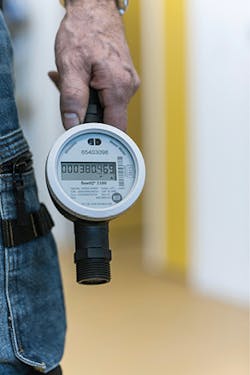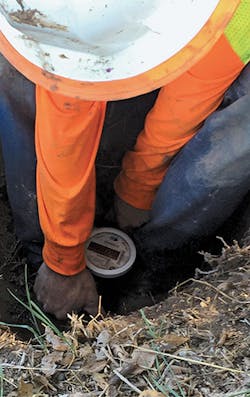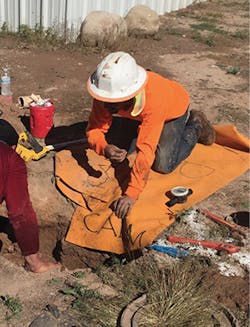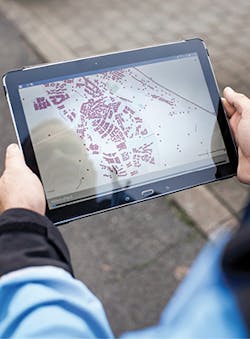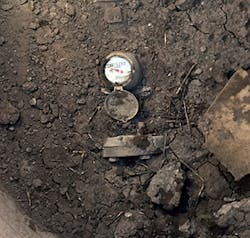The town of Olds in Alberta, Canada, faced a daunting task. The public works and utilities department, serving the town of approximately 8,000, set out in 2007 to decrease the municipality’s total water usage by 10% by January 2017, using the amount of water it consumed in 2006 as a baseline.
To meet this goal, town officials knew that they would have to address the water that leaked out of Olds’ water delivery system each year. And in this challenge, Olds is far from alone.
According to information published by energy and water resource management company Itron, more than 32 billion cubic meters of treated water leak from urban water supply systems across the world every year. That is equal to more than $18 billion of non-revenue water.
An installation in Dexter, NM
That’s a lot of lost water, a serious problem in parts of the world where water is a scarce resource. But this non-revenue water is a problem for all utilities: It can represent a significant amount of revenue that isn’t collected. This is significant during a time in which utilities and public works departments are stretching to meet stricter budget requirements.
Fortunately, there is hope, in the form of smart water meters and acoustic leak sensing technology. And both of these technologies are improving as the manufacturers of them continually optimize and update their offerings.
AN OPPORTUNITY IN OLDS
The town of Olds offers a good example of how new leak detection technology can help a utility identify problem areas, repair them, and save a significant amount of money at the same time.
The town of Olds turned to acoustic leak sensors from Itron as a way to combat leaks in its system. Itron leak sensors were installed throughout the town’s water distribution system beginning in 2010.
Shaun Fox, infrastructure technician for the public works department in Olds, pointed to the sensors as a key part of the town’s water-conservation efforts. He estimated that the town’s non-revenue water loss averaged nearly 40% a year.
Fox determined this percentage after the town of Olds had replaced its old water meters with newer, higher-tech versions. Armed with better data, Fox conducted an analysis of water-consumption data. He discovered
that at 39%, the town’s non-revenue water losses had to be addressed. Leak sensors, he decided, were the best solution.
Acoustic leak sensors are installed permanently either indoors or outdoors on the water service pipe, usually close to an existing water meter. These sensors then analyze daily sound patterns. By doing this, they can automatically detect new and pre-existing leaks.
An installation in Dexter, NM
In Olds, public works officials also rely on a web interface from Itron for network leak monitoring that interprets the data uncovered by the acoustic sensors. This is a trend today, too, with municipalities frequently relying on similar web-based interfaces that allow them to not just retrieve data, but to analyze what this data actually means.
Itron’s web-based network leak monitoring system graphically displays leak sensor locations using GIS and satellite mapping images. This points out the status and location of leaks with a series of colored flags, making it easy for department operators to quickly find system leaks. Each of the flags identifies leaks as “probable,” “possible,” “no leak likely,” or “sensor out of status.” This helps department officials prioritize possible repairs.
The Itron leak-detection system paid quick dividends for Olds. According to a case study, in the first six months of the system’s launch, the town repaired 21 leaks, recovering 287,691 cubic meters of water. This came out to a revenue savings of $177,336. Just as importantly, since the completion of the Itron project, non-revenue water losses in the town have fallen from 39% to 29%.
“This targeted analysis has already saved us money, and has also helped us as we aspire to reach our 2017 water conservation goals,” says Fox.
THE POWER OF ACOUSTIC LEAK DETECTION
John Fillinger, director of utility marketing with Milwaukee-based Badger Meter, says that some utilities do a better job of replacing aging meters and using technology such as acoustic leak detection to find leaks and reduce the amount of non-revenue water plaguing their systems.
There is no one-size-fits-all approach to water loss, Fillinger says. Different utilities will have different goals for how much water loss they can tolerate.
“Sometimes the losses occur because there are actual leaks in the system. Other losses, though, can be attributed to the meters themselves,” says Fillinger. “Utilities in general can do a better job. There are different ways to gauge non-revenue water. It varies from utility to utility. One utility might hit an 80% figure for non-revenue water and be happy about that. But for others, that figure might not be an adequate goal. Each utility is different.”
Kamstrup’s READy AMR in use
Jack Merrell, senior marketing manager with Itron, says that aging water infrastructure, and the leaks that come with it, remain a problem for water utilities across the country.
And Merrell says that this is a trend that likely won’t change any time soon. Water loss will remain a challenge with which utility managers must deal, he says.
“Despite the fact that our planet’s population continues to increase, the supply of our planet’s water remains the same,” says Merrell. “This challenge is going to continue to exist, but it just might shift to different parts of the country as populations migrate based on the availability and cost of water. Our planet is not getting any more water, so it is important that we are all good stewards in sustaining such a precious resource.”
The challenge for municipalities and utilities is that the only way to eliminate leaks is for them to replace or repair their aging pipes. That, unfortunately, can be expensive.
But as Merrell says, it has been estimated that approximately 60% of the water lost by utilities comes from pipes that are more than 100 years old. “The pipes are a big part of the problem,” says Merrell. “Utilities need to be able to be proactive about repairing them. That takes an investment.”
Acoustic leak detection is an effective tool to help utilities identify those pipes that are causing the most water loss in their systems so they can prioritize repairs, Merrell says. That’s because this technology helps utilities find leaks that they normally could not see until water actually rises to the surface.
Once utilities, using sound detection, discover a leak, they can then accurately send a truck to repair it before the leak becomes too large.
A Kamstrup meter in Dexter, NM
The key for utility managers and supervisors is to be able to explain to the municipal boards that often control their purse strings just how important early detection of leaks is. Utility officials need to be able to explain, too, how finding and fixing leaks quickly can result in significant annual savings, enough to justify the expense of acoustic testing.
Merrell says that Itron’s acoustic leak detection solutions are used in conjunction with advanced metering infrastructure and automatic meter reading—tech better known as AMI and AMR. Using AMR or AMI together with acoustic leak detection allows utilities to better monitor the health of their entire water-distribution system, Merrell says.
“This is an investment that pays off,” says Merrell. “Anytime you are being proactive, you are empowered to prioritize and to be efficient in the employment of resources. When you are being proactive, actively searching out and repairing leaks, you have greater control over your system and resources. Cities that are going down the path of becoming smart cities are interested in this kind of technology. One of the objectives in becoming a smart city is encouraging people and businesses to move to your community. This will only increase the demand on water systems. Cities need to make sure their water supplies can meet that demand. Water supply will continue to be a challenge, and technology like this can help communities better control that supply.”
A RISE IN PROACTIVE UTILITIES
Jimmy Carter, senior director of corporate field services with Palm Springs, CA-based American Leak Detection, says that his company is fielding a steady stream of calls from utilities looking for its leak-detection services. American Leak Detection performs its own leak surveys, helping utilities find leaks throughout their water-distribution systems.
Carter says that utilities on both the East and West Coasts are working with pipes that are sometimes more than a century old. And these utilities have rarely received the funding they need to keep up with the maintenance demands that such old infrastructure poses.
In other words, they don’t receive enough money from their municipalities to replace the older water lines that are now springing leaks.
“There are so many miles of line under the ground. It is mind-boggling to think of how many miles there are in the ground that are more than 75 years old,” says Carter.
Carter says that American Leak Detection, today, is running a leak survey for a utility in Arizona that has 325 miles of water lines under the ground. American Leak Detection is also providing a survey of more than 400 miles of water lines for a utility in Florida.
“To think about changing out so many miles of lines can be intimidating to utilities,” says Carter. “To bring in new material and to replace the old lines can be a big capital expense.”
American Leak Detection technicians rely on acoustic leak detection to help utilities find the worst of the leaks plaguing their systems. This is most effective during the quietest times in a water-distribution system. The company’s sensors can pick up the sounds of a leak more easily at three in the morning when the water system is quieter.
American Leak Detection also performs velocity checks on water pipes. These tell technicians if a particular water line is building up deposits that restrict the flow of water through them.
“The goal for a water district is to recover the non-revenue water that is being lost,” says Carter. “That is all treated water. It has already used up power and chemicals. That makes it some pretty expensive water.”
In addition to acoustic monitoring, utilities that work with American Leak Detection should also look at the age of their water meters, Carter says. Smart meters can help utilities more accurately track how much water they are delivering to their customers, helping them capture more revenue.
“The older the meters are, the slower they move,” says Carter. “If a utility is not on a regular maintenance schedule where they change out meters every five years, that can be part of the problem. They might be pushing more water to the residential and commercial side than is actually being monitored. That can account for a significant part of their water loss, too.”
Carter says that utilities across the country are becoming more proactive in tackling leaks. Some, he says, are installing permanent loggers that constantly track their pipes.
These proactive utilities can then send employees on a regular basis to drive by the loggers and automatically collect data. Some might have loggers that automatically send data to computers in a centralized office. These permanent loggers are an effective way to find leaks early. But installing them is not inexpensive, Carter says.
Carter says that Las Vegas is a good example of municipality that has paid for the permanent loggers. This isn’t surprising, considering how valuable of a resource water is in this part of the country.
“Different parts of the country with big water systems and where water conservation is critical are the ones who have been most proactive with permanent loggers,” says Carter.
A customer using READy tablet.
SMARTER, MODERN METERS CAN HELP
Water utility workers with the city of Dyer, TN, once read their water meters manually, relying on a meter book or a handheld device to type in the numbers. This was far from efficient. Nathan Reed, city recorder for Dyer, says that this process took three men three days to enter the numbers. The process then required two more days for re-reads.
Even worse? Reed says that the city still had reading errors that reduced the amount of revenue that the city’s utility collected for delivering treated water. “The time spent doing this meant we were not groundskeeping our parks or repairing other infrastructures in our city for our residents,” says Reed.
City officials decided to replace their old meters with ultrasonic smart water meters from Kamstrup. The system included a remote reading feature, meaning that the City would no longer have to send municipal personnel to personally read the meters or enter the numbers from them.
According to a case study from Kamstrup, the city of Dyer is now finding leaks throughout its water-delivery system faster. This has helped the city reduce its water loss. At the same time, the accurate meters provided by Kamstrup have helped Dyer officials boost their water revenues.
Kali Gerhardt, marketing manager with Kamstrup, says that old meters can cost utilities large amounts of money.
“Inside a home, say, there could be a leak, but an old meter is not catching it,” says Gerhardt. “The water utility is delivering the water at the retail rate, but is not getting enough revenue for it. It is spending on the pumping and electrical costs of delivering that water, but is not getting revenue for its efforts. That is one of the biggest issues that municipal water districts are facing today.”
There is no easy solution for the problems caused by aging infrastructure. Gerhardt points to research from the American Water Works Association showing that by 2040 it will cost $30 billion a year for utilities to replace their aging infrastructure.
“Frankly, we are not that far from 2040,” says Gerhardt. “It sounds like it’s in the far future, but it really isn’t. The water utilities are aware of it, for sure. It is not new information for them. We all have to chip in to figure out how we can address this challenge.”
Replacing aging meters is one way for utilities to capture lost water revenue and identify leaks in their systems more quickly, Gerhardt says. By capturing and repairing leaks more quickly, utilities can save more revenue that they can then use on repairing or replacing aging infrastructure. They can also catch leaks before they grow and cause even more damage to their pipes.
Gerhardt says that leaks and aging meters that don’t accurately measure water flow are significant problems for utilities. She points to research from the EPA indicating that the average household in the US has leaks that account for 10,000 gallons of wasted water a year.
Kamstrup’s advanced smart meters can measure extremely low flows of water, giving utilities an edge in tracking down leaks when they are smaller rather than larger problems, Gerhardt says.
“We can help utilities recoup that revenue that they might otherwise miss,” she says. “Within two years, by recovering this lost revenue, many utilities can get a return on their investment on smart meters that covers the cost of installing them.”
Being able to show this quick return on investment helps convince elected officials to provide the investment dollars that utilities need to purchase advanced meters.
A field technician performs a leak detection survey.
“Utilities can keep instituting rate increases to pay for improvements, but elected officials don’t like that,” says Gerhardt. “Consumers don’t like that, either. If they can instead capture that lost water, they can go without the rate increases. Leaks can easily turn into bursts, into water-main breaks. There are big costs associated with that. With better meters, utilities can prevent those breaks. There is a lot of value that can come from a more proactive approach to dealing with leaks.”
Gerhardt says that utility officials are not hiding from the infrastructure problems they are facing. She points to the more than 25 industry conferences she has attended during the last three years. Everyone at these conferences is deeply concerned about infrastructure issues, Gerhardt says. They are all interested in making changes that can help preserve their water lines, pumps, and filters. And they are all seeking ways to invest in repairs and replacement infrastructure, she says.
Gerhardt points to Georgia. This state, she says, is on the forefront of water-loss control. Utilities here must complete water audits every year. The Georgia Association of Water Professionals holds training sessions for utility officials several times a year giving them advice on how to properly perform a water audit.
That leads to one question: What about those states and utilities that aren’t focusing on capturing leaks and repairing or replacing their aging infrastructure? What is holding them back?
Badger Meter’s EyeOnWater consumer portal
“Sometimes, utilities struggle to communicate to their elected officials that, say, their meters are not capturing as much revenue as they should be,” says Gerhardt. “Some utilities have the attitude that if it’s not broken, why should they fix it? They have enough to do already. There is some of that mentality out there. But I am seeing a shift in attitude. Now, utilities want to know why they should choose our meters over someone else’s. The concept of these smarter meters is no longer new to them. That is a positive change.”
Fillinger says that utilities hoping to reduce non-revenue water need as much information about their systems’ daily performance as possible. Today’s advanced water meters can help provide that information, he says.
Fillinger pointed to a utility that recently installed Badger Meter’s BEACON Advanced Metering Analytics cloud-based software suite. BEACON offers managed, fixed-network, mobile, and consumer-engagement systems that allow utility workers to capture meter data through cellular, fixed network, or mobile communication technologies.
Armed with information gathered through this system, the utility was able to contact customers whose businesses or residences were showing unusual water-use patterns. As an example, the utility contacted a homeowner, saying that at 3 p.m. the previous day, this customer’s water usage suddenly spiked. Since then, the water usage continued at these higher than normal levels.
The homeowner was a plumber, and didn’t believe there was a leak anywhere in his home. But when a customer service representative from the utility told him the timeline of the water spike—from 3 p.m. the previous day and still continuing—the plumber was suddenly apologetic. The homeowner recently had a tree planted outside his home. He had set up a hose to irrigate the new tree the previous afternoon and had forgotten to turn it off.
“The utility was able to connect the dots,” says Fillinger. “The ability to provide increased customer service, to provide data that they didn’t have available to them in years past, is a great tool when you’re trying to identify leaks and protect your infrastructure. This ability helps justify the money spent on these systems. Customers want more information. We can now provide it for them.”